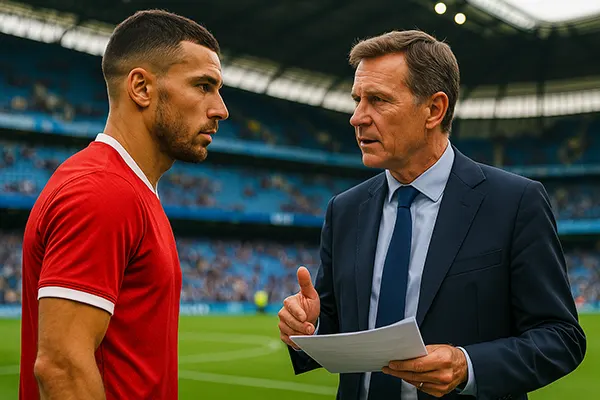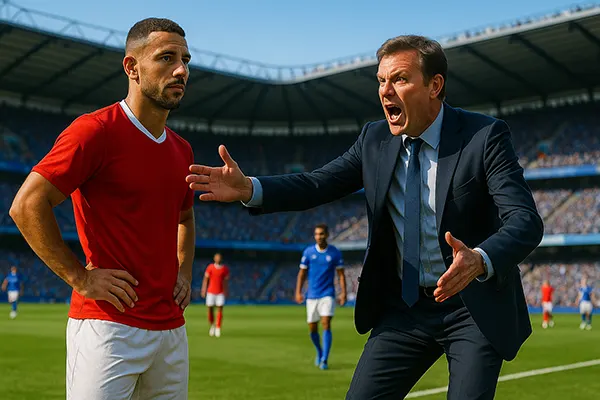
Transfer Talks: What the Future Holds for One of Football’s Top Champions
The football transfer market in 2025 has once again proven that no club, no matter how dominant, can remain static. With the season approaching its decisive phase, discussions surrounding the future of one of Europe’s top champions have reached a fever pitch. The decisions made in the coming weeks could redefine both the player’s legacy and the strategic ambitions of his club.
The Current Situation: A Turning Point for Club and Player
The ongoing transfer negotiations between the star forward and his current club have become the central story in European football this year. While both sides have expressed mutual respect, it’s clear that financial expectations and sporting ambitions no longer align perfectly. Reports from several leading sports outlets suggest that the player’s representatives are exploring options across England, Spain, and Saudi Arabia.
From a sporting perspective, the club remains competitive, but there are questions about its long-term strategy. The potential departure of their most valuable player raises concerns about replacing his leadership and consistency. Club executives have already begun to identify possible successors, focusing on younger talents with room to develop under less financial strain.
For the player, this could be the final major contract of his career. Beyond salary considerations, he is looking for a project that values his experience and offers a realistic shot at international trophies. Sources close to his camp indicate that negotiations are not only about money but also about his post-playing career within football management.
Market Reactions and Expert Opinions
Analysts across the football world have been divided on the wisdom of such a move. Some argue that the player’s age and injury record make it a calculated risk for potential buyers. Others insist that his presence would bring immediate commercial and sporting value, especially for clubs seeking global recognition.
Bookmakers and data analysts have noticed how each rumour affects betting odds and fan sentiment. Market fluctuations often mirror public expectations, showing just how much influence a single player can have on the perception of club success. Meanwhile, financial experts point out that his transfer could generate over €120 million in combined sponsorship and media impact within a single year.
Former teammates have also voiced their support. Many describe him as a professional who constantly sets the standard for discipline and preparation. His departure, they believe, will not just leave a tactical gap but also affect the dressing room atmosphere that has been built around his leadership for nearly a decade.
Strategic Implications for the Club
For the club’s board, the challenge extends far beyond replacing one individual. The decision marks a crucial test of their long-term planning and adaptability in a market increasingly driven by financial fair play regulations. While the club has maintained a stable revenue stream, the global economic environment continues to pressure wages and transfer policies.
The sporting director has reportedly prioritised maintaining squad balance and avoiding short-term panic buys. The focus has shifted towards nurturing academy players and securing versatile midfielders who can adapt to multiple tactical systems. This strategy reflects a broader trend among European giants to become more financially sustainable without sacrificing competitiveness.
Fans, however, remain sceptical. Many fear that losing their star player could signal the end of a dominant era. Yet, some supporters see this as a necessary evolution—a chance to refresh the team’s identity and embrace a more collective approach rather than relying on one superstar to deliver results week after week.
How the Football Landscape Is Changing
The 2025 transfer market underscores a shift in power dynamics. Clubs from emerging leagues, particularly in the Middle East and the United States, continue to challenge Europe’s dominance by offering contracts previously considered unimaginable. This transformation has forced traditional clubs to innovate in terms of marketing, youth development, and fan engagement.
Digitalisation and data analytics also play a growing role in transfer decisions. Scouting departments now rely heavily on advanced performance metrics, allowing them to identify undervalued players who can fit specific tactical roles. The reliance on big-name signings is slowly giving way to evidence-based recruitment models.
Moreover, fans are more informed and vocal than ever. Social media platforms provide instant feedback on every rumour and club statement. This new level of transparency has turned supporters into active participants in transfer debates, influencing public relations strategies and even contract negotiations.

The Road Ahead: What to Expect
As negotiations enter their final stages, the player’s decision is expected before the summer transfer window officially opens. Sources close to both camps suggest that the outcome will depend on the club’s willingness to meet specific performance-related clauses rather than simply increasing the base salary. This approach aligns with the industry’s broader trend toward incentive-based contracts.
Should the player decide to move abroad, his departure will mark the end of an era not only for his club but also for the league as a whole. His influence on youth development, brand partnerships, and international fan growth cannot be understated. Regardless of his next destination, he will remain one of the most recognisable faces in modern football.
For the club, the upcoming season represents both a challenge and an opportunity. A successful rebuild could reaffirm its position among Europe’s elite and demonstrate that no player is irreplaceable. Failure, on the other hand, might raise questions about leadership and long-term vision at the top level of management.
Final Reflections on Legacy and Transition
Transfers of this magnitude rarely concern only the player’s destination. They reflect deeper changes in how football operates—balancing tradition with modernisation, emotion with financial logic. The outcome of this particular saga will influence how other top players approach the final years of their careers.
As the story unfolds, both fans and analysts are reminded that football’s true power lies in its ability to evolve. No single player defines the game, yet each one contributes to its ongoing narrative of ambition, loyalty, and reinvention. The coming months will show whether this champion’s next step becomes a farewell or a fresh beginning.
Whatever the result, 2025 will be remembered as a year when the definition of legacy in football was rewritten—through negotiation, decision, and courage to embrace change.
